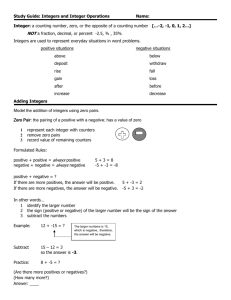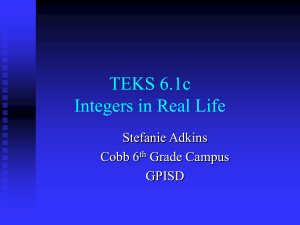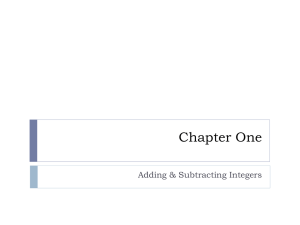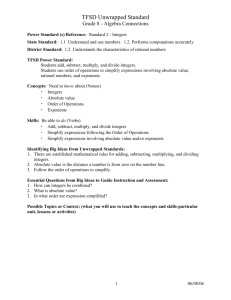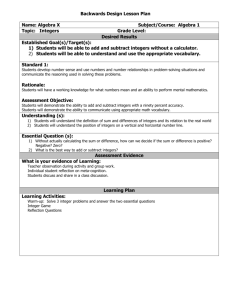doc
advertisement
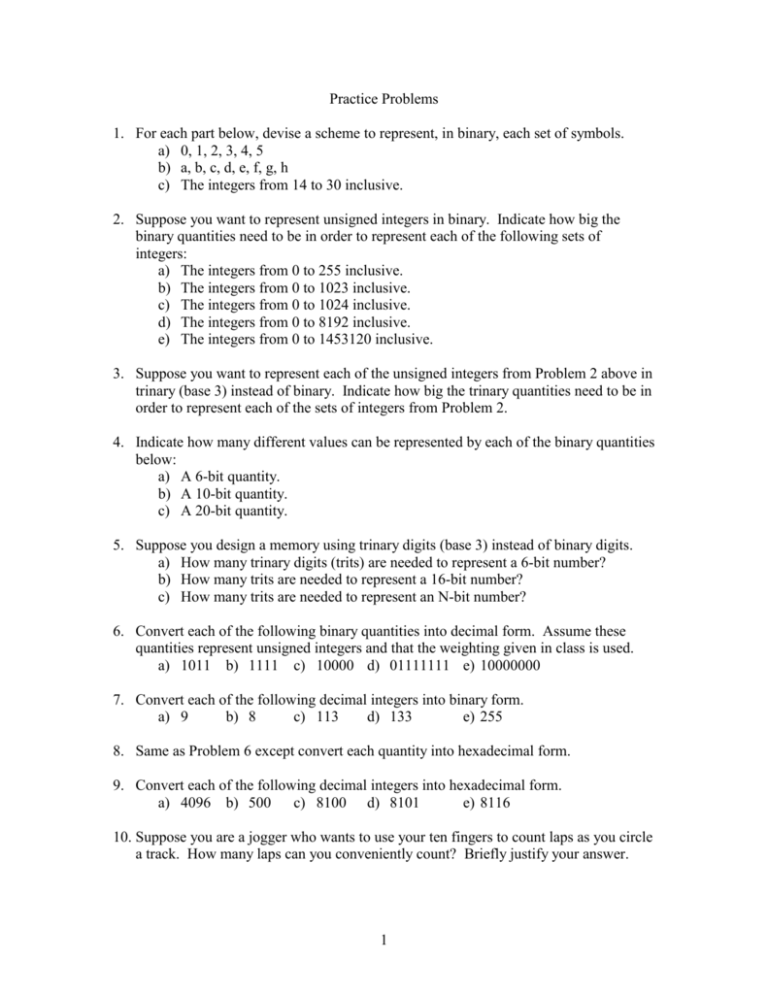
Practice Problems 1. For each part below, devise a scheme to represent, in binary, each set of symbols. a) 0, 1, 2, 3, 4, 5 b) a, b, c, d, e, f, g, h c) The integers from 14 to 30 inclusive. 2. Suppose you want to represent unsigned integers in binary. Indicate how big the binary quantities need to be in order to represent each of the following sets of integers: a) The integers from 0 to 255 inclusive. b) The integers from 0 to 1023 inclusive. c) The integers from 0 to 1024 inclusive. d) The integers from 0 to 8192 inclusive. e) The integers from 0 to 1453120 inclusive. 3. Suppose you want to represent each of the unsigned integers from Problem 2 above in trinary (base 3) instead of binary. Indicate how big the trinary quantities need to be in order to represent each of the sets of integers from Problem 2. 4. Indicate how many different values can be represented by each of the binary quantities below: a) A 6-bit quantity. b) A 10-bit quantity. c) A 20-bit quantity. 5. Suppose you design a memory using trinary digits (base 3) instead of binary digits. a) How many trinary digits (trits) are needed to represent a 6-bit number? b) How many trits are needed to represent a 16-bit number? c) How many trits are needed to represent an N-bit number? 6. Convert each of the following binary quantities into decimal form. Assume these quantities represent unsigned integers and that the weighting given in class is used. a) 1011 b) 1111 c) 10000 d) 01111111 e) 10000000 7. Convert each of the following decimal integers into binary form. a) 9 b) 8 c) 113 d) 133 e) 255 8. Same as Problem 6 except convert each quantity into hexadecimal form. 9. Convert each of the following decimal integers into hexadecimal form. a) 4096 b) 500 c) 8100 d) 8101 e) 8116 10. Suppose you are a jogger who wants to use your ten fingers to count laps as you circle a track. How many laps can you conveniently count? Briefly justify your answer. 1 For problems 11-14 below, assume 4-bit words and integers represented in 2’s complement form. 11. Which of the following binary numbers are negative? a) 1000 b) 0111 c) 1010 12. Negate the following numbers: a) 1011 b) 0111 c) 1000 13. Give the binary representation for: a) -3 b) -8 c) 5 14. Perform the following operations and indicate, in each case, whether or not overflow occurs: a) 1000 b) 1000 c) 1111 d) 0000 +0001 +1111 0001 1111 15. An expedition to Mars found the ruins of a civilization. The explorers were able to translate the mathematical equation: 5x2 – 50x + 125 = 0 with the solutions: x = 5 and x = 8. The x = 5 solution seemed okay, but x = 8 was puzzling. The explorers reflected on the way in which Earth’s number system developed. How many fingers would you say the Martians had? 16. Suppose Venetians use a trinary number system with their three digits defined as follows: X denotes +1 Y denotes 0 Z denotes -1 Numbers in their system consist of four trinary digits with the value of the number B3B2B1B0 given by the expression 27B3 + 9*B2 + 3*B1 + B0. For example, XZYX = 19. a) What values does ZYYX represent? b) How do Venetians represent +30? How do they represent -30? c) How many different values can Venetians represent in their system? d) Suppose Max is the largest positive integer Venetians can represent in their system. Can they represent all integers in the range from 0 to Max, inclusive? What about from -Max to 0, inclusive? 2 17. Give a truth table for each of the following logic expressions: a) X (X+Y) b) X + X Y 18. Derive a truth table having three inputs X, Y, C, and one output, Z, such that Z equals X if C is 0 and Z equals Y if C is 1. 19. Derive a truth table having four inputs and one output such that the output is a 1 if and only if the number of 1s in the inputs is even (assume zero is an even number). 20. Give a truth table that will take as input a 4-bit binary number and will give as output a 1 if the input value represents a prime. Otherwise, the output value is to be a 0. Assume 0 and 1 are not prime. 21. A farmer has two barns, a North barn and a South barn, a dog, a goat, and a cabbage. The dog will eat the goat and the goat will eat the cabbage (provided they are in the same barn). Give a truth table that will have value 1 if, and only if, anything is in danger of being eaten. For example, the expression has value 1 if the goat and cabbage are both in the North barn. 22. Derive the canonical sum-of-products expression corresponding to each truth table below. You will have one expression for each table. a) A 0 0 1 1 B | Z 0 1 1 0 0 0 1 1 b) A 0 0 0 0 1 1 1 1 B 0 0 1 1 0 0 1 1 C | Z 0 0 1 0 0 0 1 1 0 0 1 1 0 1 1 0 c) A 0 0 0 0 0 0 0 0 1 1 1 1 1 1 1 1 B 0 0 0 0 1 1 1 1 0 0 0 0 1 1 1 1 C 0 0 1 1 0 0 1 1 0 0 1 1 0 0 1 1 D | Z 0 0 1 1 0 1 1 0 0 1 1 0 0 0 1 0 0 1 1 0 0 0 1 0 0 0 1 0 0 0 1 0 23. Give the canonical sum-of-products expression for the truth table of Problem 18. 24. Give the canonical sum-of-products expression for the truth table of Problem 19. 25. Give the canonical sum-of-products expression for the truth table of Problem 20. 3 26. Give the canonical sum-of-products expression for the truth table of Problem 21. 4 27. A full adder is a circuit that will take three inputs, two data bits and a carryin bit, and will produce two outputs, a sum output and a carryout output. Design two circuits , one for the sum bit and one for the carryout bit. 28. Your job is to design a circuit that will accept four inputs W, X, Y, Z and will produce seven outputs such that the inputs represent an integer in the range 0 - 15 inclusive and the outputs represent the segments of a seven-segment display that will display, for each input value, the corresponding hexadecimal digit. Use the scheme presented in class. 29. Give, for each state diagram below, a corresponding implementation-level state table. a) S0 S1 S2 S2 b) S0 S1 S2 S4 S4 S3 S4 S5 S0 30. Give a state diagram and an implementation-level state table for a state machine having four states and one 1-bit input, i, such that: if i=1 the machine makes a transition “upwards” S0 S1 S2 S3 S0 if i=0 the machine makes a transition “down” S0 S3 S2 S1 S0 31. Design a circuit, in the form of next state equations in canonical sum-of-products form, that will repeatedly cycle through the sequence 000 001 010 011 100 101 110 111 32. Design a circuit, in the form of next state equations in canonical sum-of-products form, that will repeatedly cycle through the sequence 000 001 010 011 100 5 33. Design a circuit, in the form of next state equations in canonical sum-of-products form, that will implement the following state machine Curr XY 00 00 01 01 10 10 11 11 Input I 0 1 0 1 0 1 0 1 Next XY 11 01 00 10 01 11 10 00 34. Design a state machine that will read in a sequence of digits, one at a time, and will light a lamp if the sequence contains an odd number of 1s. 35. Design a state machine that will read in a sequence of digits, one at a time, and will light a lamp if the decimal value represented by the sequence is divisible by 3. Assume reading is to start with the leftmost digit. 36. Design a state machine that will read in a sequence of binary digits, one at a time, and will light a lamp at any point when the number of 1s read in is divisible by three. 37. Design a state machine that will read in a sequence of binary digits, one at a time, and will stop when it has read in five 1s. 38. Given the state machine of Problem 33, indicate for each input sequence below, the state the machine is in after the last digit has been read in. Assume the digits are read in from right to left. a) 1110001100 b) 111111 c) 513 1s d) 11101111110011000000 e) 555 1s followed by 234 0s 39. An n-state State Machine is to have only a clock input and a single output Q whose value is 1 if and only if the number of clock ticks (after reset) is either a multiple of 3 or a multiple of 2 (and 0 otherwise). How many states are required for this Finite State Machine? Justify your answer with a sketch of a state diagram for your machine. Hint: More than two states are required. 40. In this problem you are to design a state machine with four states, numbered 0 through 3, and a two-bit number, n, as its only input. The next state is always the (current state + n). Draw the state diagram for this state machine. Label all states and arrows. 6 41. Give a next state table corresponding to the state diagram given below. Note that you have one input variable, W. Label your table appropriately. Do not include any output logic. 0 0 1 3 0,1 4 0,1 1 1 0 0,1 State Lights 0 R,G 1 R,Y 2 G,R 3 Y,R 4 R,R,W Input: W = 0, walk off W = 1, walk on 2 42. Give a state diagram for a state machine that will read in a sequence of binary digits, one at a time, and will stop when at least three consecutive 1s followed by a 0 have been read in. To “stop” the machine, merely have it orbit in the state it reaches after a successful match. 43. Design a state machine that will repeatedly display the sequence given below. You are to give a state diagram for your machine and are to give a truth table for the output logic. 000 010 000 101 44. You are to design a controller, in the form of a state machine, for a 20¢ gumball machine. Your controller circuit should accept one input, C, to be interpreted as follows: C = 0 denotes an input of 5¢, C = 1 denotes an input of 10¢. You are to light a light to indicate that at least 20¢ has been entered. Two seven-segment displays are to display the cumulative amount entered up through 20¢. Any amount over 20¢ is merely displayed as 20¢. Once you enter 20¢ or more, subsequent entries will be accepted but ignored (i.e., you are to stay in the “stopping” state). Your solution should be in the form of a state machine together with the output logic required to display the amount entered. You are to assume that the seven-segment displays are already wired to 4-bit decoders as in the lab kits so your output logic should provide inputs to these decoders together with a signal to control the lamp. 7 45. Suppose you are given as a basic building block the 1-bit comparator discussed in class. This comparator has two 1-bit inputs (A and B) and three 1-bit outputs (AEQBout, AGTBout, and ALTBout) with the following meanings: ALTBout = 1 if A is less than B, 0 otherwise AEQBout = 1 if A equals B, 0 otherwise AGTBout = 1 if A is greater than B, 0 otherwise This comparator has three 1-bit inputs (AEQBin, AGTBin, and ALTBin) with the meanings: ALTBin = 1 if a higher-order compare found the left operand less than the right operand AEQBin = 1 if a higher-order compare found the left operand equal to the right operand AGTBin = 1 if a higher-order compare found the left operand greater than the right operand Use your 1-bit comparator basic building blocks to design a 4-bit comparator that will compare two 4-bit unsigned integers, Be sure to include in your answer the values you will assign to the leftmost AEQBin, ALTBin, and AGTBin inputs. 46. Give logic equations for the 1-bit comparator of Problem 45 above. 47. a) Give a truth table for the 1-bit maximizer component discussed in class. b) Design, using the 1-bit maximizer component above, a 4-bit maximizer component. Assume the data inputs to the 4-bit maximizer are unsigned integers. 48. Design, using 2-input maximizer components, an 8-input maximizer component. 49. Design, using 2x1 multiplexers, a 4x1 multiplexer. 50. Given a supply of 2-to-4 decoders, together with a supply of inverter gates, show how to get a 3-to-8 decoder circuit. Assume each of your 2-to-4 decoders has an ENABLE input (ENABLE=1 enables the decoder) but you need not include an enable capability on your 3x8 circuit. 8 51. Suppose you are given a supply of Eval components, each of which takes three integer inputs, A, B, C, and produces one integer output, Z, where Z = A*B + C. (Note that * denotes multiplication, + addition) Using these Eval components, and no other components, design a reasonably efficient polynomial evaluation circuit that will compute the value Y = A0 + A1*X1 + A2*X2 + A3*X3 + A4*X4 . Assume the values for Ai and X are given. Ignore any overflow considerations. 48’.Same as Problem 48 except you are to design 16-input maximizer and a 7-inoput maximizer. 49’.Same as Problem 49 except you are to design an 8x1 multiplexer. 50’.You are to design a 4-to-16 decoder using 3-to-8 decoders as basic building blocks. You can use other gates such as inverters, OR gates, and AND gates as necessary. 52. You are to design a 4-input sorter using 2-input sorters as basic building blocks. 53. Design an inside-circuit for a 2-input sorter. Use a comparators, multiplexers, etc. as basic building blocks. 54. Design a 2-input multi-function circuit that will perform the following operations: A+B shift_left(A) (A+A) A+B+1 shift_left(A)+1 (A+A+1) Assume you have available a multiplexer and a full adder component. 55. Consturct a D-REG component (as given in class) from D flip-flops. 56. Suppose you are given a full adder, a multiplexer, inverters, AND gates, and OR gates. Construct a 2-function circuit that will add and substract. 9 57. Construct a multi-purpose register that will do the following: LDADR INC1 INC2 Operation 1 0 0 External load 0 1 0 i := i+1 0 0 1 i := i+2 Otherwise No-op Assume you have available a supply of multiplexers, inc1, and inc2 components. 58. Give the “instructions” to perform the computations of Lab 7, Step 1. 59. Give the “instructions” to perform the computations of Lab 7, Step 2. 60. Design the control for Lab 8, Step 2. Your answer should be in the form: a) A state diagram (having eight states). b) Output logic (i.e., values of the eight control signals for each state). 61. Hand simulate the computation of Lab 8, Step 3 for each of the following: a) A = 9, B = 3 b) A = 12, B = 8 c) A = 3, B = 2 62. Hand simulate the computer presented in class for each of the following: a) R2 := -1 b) R2 := R3-1 c) R2 := R3+R1 63. Give the sequence of control signals for the computation indicated below. For each step indicate those control signals that are asserted in that step. A mROM[0] B mROM[1] SRAM[0] A+B 64. You are to hand translate and hand execute the program segment given below. Assume the program is to start in mROM location 0. Indicate the contents of both the mROM and SRAM upon the completion of program execution. cmove(10,0) cmove(15,1) add(0,1,2) sub(0,1,3) halt 65. Give nanocode for the instruction cadd(cx,y,z). Recall that the nanocode is the sequence of control signals required to execute the instruction. You can give your answer in symbolic form. 66. Give nanocode for cmove(cx,y) 67. Give nanocode for move(x,y) 10 68. Give nanocode for neg(x,y) 69. Give nanocode for sub(x,y,z) 70. Give nanocode for cmp(x,y) 71. Give nanocode for the instruction of your choice. You may not choose halt or csub(cx,y,z). Suggested instructions include, but are not limited to, inc(x) (x <x>+1), dec(x) (x <x>-1), and swap(x,y) (x <y>; y <x>). 71’.Hand translate the program: cmove(3,10) cmove(4,11) bne(Lab1) move(10,12) move(11,13) jmp(Lab2) Lab1: move(11,12) move(10,13) Lab2: halt 72. Give the contents of the condition code register for cmp(10,20) for each pair of values given below for SRAM locations 10 and 20. Assume 8-bit words with signed integers represented in 2s-complement form. All numbers are given in hexadecimal notation. 10 20 N Z V C a) 7F 01 b) 7F FF c) 80 01 d) 03 04 e) 04 03 f) 01 01 73. Give next state logic, in MacAbel form, to transfer control to State S8 provided the condition specified by each conditional branch instruction below is satisfied. a) bne(dst) b) ble(dst) c) bge(dst) 11 74. Translate the following program segment into microcode that is stored in the mROM starting at location 0. Assume that variables a, b, c, d are assigned SRAM locations 0, 1, 2, 3 respectively and that they have already been in initialized. a := a+b+c+d; a := a-b-c; a := a+1; a := b+2; a := b+c+d+4; 75. Translate each program segment below into microcode that is stored in the mROM starting at location 0. Assume that variables a and b are assigned SRAM locations 0 and 1 respectively. a) a := 0; b := 3; if a != b then goto Lab1; a := 2; halt; c) a := 3; b := 4; if a > b then goto Lab1; a := 2; halt; b) a := 3; b := 4; if a <= b then goto Lab1; a := 2; halt; 76. Same as Problem 75 above except for the program segments below. a) a := 3; b := 4; if a <= b b) then else a b a b := := := := 5; 6; 6; 5; endif; halt; a := 0; b := 0; while a < 5 do b := b+a; a := a+1; endwhile; halt; 77. Give the clock period corresponding to each clock frequency below. a) 16 MHz b) 66 MHz c) 266 MHz 78. Given that the propagation delay for a sort2 component is 10 ns, calculate the propagation delay for a 4-input sorter. 12 79. Given that the contamination delay of a sort2 component is 10 ns, calculate the contamination delay for a 4-input sorter. 80. A certain adder component takes two digits and a carry-in as inputs and produces a one-digit sum and a carry-out as outputs. It does this in 25 ns. We can hook these components together (attaching the carry-out of one adder to the carry-in of the next adder) in sequence to build an N-digit adder. a) Give a formula for the time it takes this adder to produce an N-digit sum and carry. b) Suppose we redesign the adder component so that it can produce its carry-out in 10 ns with the sum digit still taking 25 ns to produce. Now, how long does it take to produce an N-digit sum and carry? 81. Consider a rectangular NxN array of identical combinational devices, connected as indicated below. a) What are the propagation and contamination delays from D to Q in terms of the tpd and tcd of each device? b) Extend your results from part a) above to an analogous 3-dimensional NxNxN structure. D Q 13 82. We are interested in the behavior of the following state machine, called the E Module: E M odule External Inputs Clock Comb Logic . Register Comb Logic External Outputs The propagation delay of the top Comb Logic circuit is 100 ns and the propagation delay of the bottom Comb Logic is 100 ns. Both Comb Logic circuits have a contamination delay of 0 ns. The register is defined by the following parameters: setup time = 25 ns, hold time = 5 ns, propagation delay = 25 ns contamination delay = 5 ns a) What is the minimum setup time for the E Module? Show work. b) What is the minimum hold time for the E module? Show work. c) What is the minimum propagation delay for the E Module, as measured from the clock tick? Show work. d) What is the minimum allowable clock period for the E Module that will ensure proper operation, assuming the above timing specifications are met? Show work. e) Suppose that two or more E modules are chained together with each attached to a common clock. What is the minimum allowable clock period that will ensure proper operation of both E modules in this cascade configuration? Show work. 14 83. Give precedence graphs for the following: a) r(x) = g(f(x),h(x)) b) r(x) = g(f(h(x)),h(x)) c) r(x) = g(f(h(x)),h(f(x))) d) r(x) = f(h(p(g(x),p(x,h(x))))) 84. Give all precedence relations for each computation in Problem 83. 85. Give all serializations for each computation in Problem 83. For each computation, your serializations should be consistent with that computation’s data dependencies. 86. We want to design a sequential circuit to compute r(x) = g(g(f(x),h(x)),f(h(x))) using (combinational) modules that compute g(x,y), f(x), and h(x). a) Draw a data dependency graph for r(x). b) Suppose you are allowed to use at most one g(x,y) module in your design for the circuit to compute r(x). Does this limitation require the addition of nonessential precedence constraints to the precedence graph for one computation of r(x)? Briefly explain. c) Suppose you are allowed to use at most one f(x) module in your design for the circuit to compute r(x). Does this limitation require the addition of nonessential precedence constraints to the precedence graph for one computation of r(x)? Briefly explain. 87. Using the data path of Figure 7.2 in the text, give the sequence of steps for the computation r(x) = p(f(x),h(x)). 88. a) You are to design the control for a circuit to compute r(x) = f(h(p(g(x),p(x,h(x))))) You are given the data path of Figure 7.7 in the text with the propagation delays (in time units) as follows: f = 2, h = 4, g = 5, p = 3. Give your answer in the form of a state diagram and a table for the output logic required to cause the datapath to compute r(x). You may give your output logic in register transfer form. Assume the last state in your state machine is an orbit state. Assume, as we did in class, that each state in your state machine takes one time unit. Also, give a timing diagram to illustrate the behavior of the computation. Recall that a register transfer occurs at the end of the state in which it appears so the register transfer operation associated with state S0 is A,B x 15


